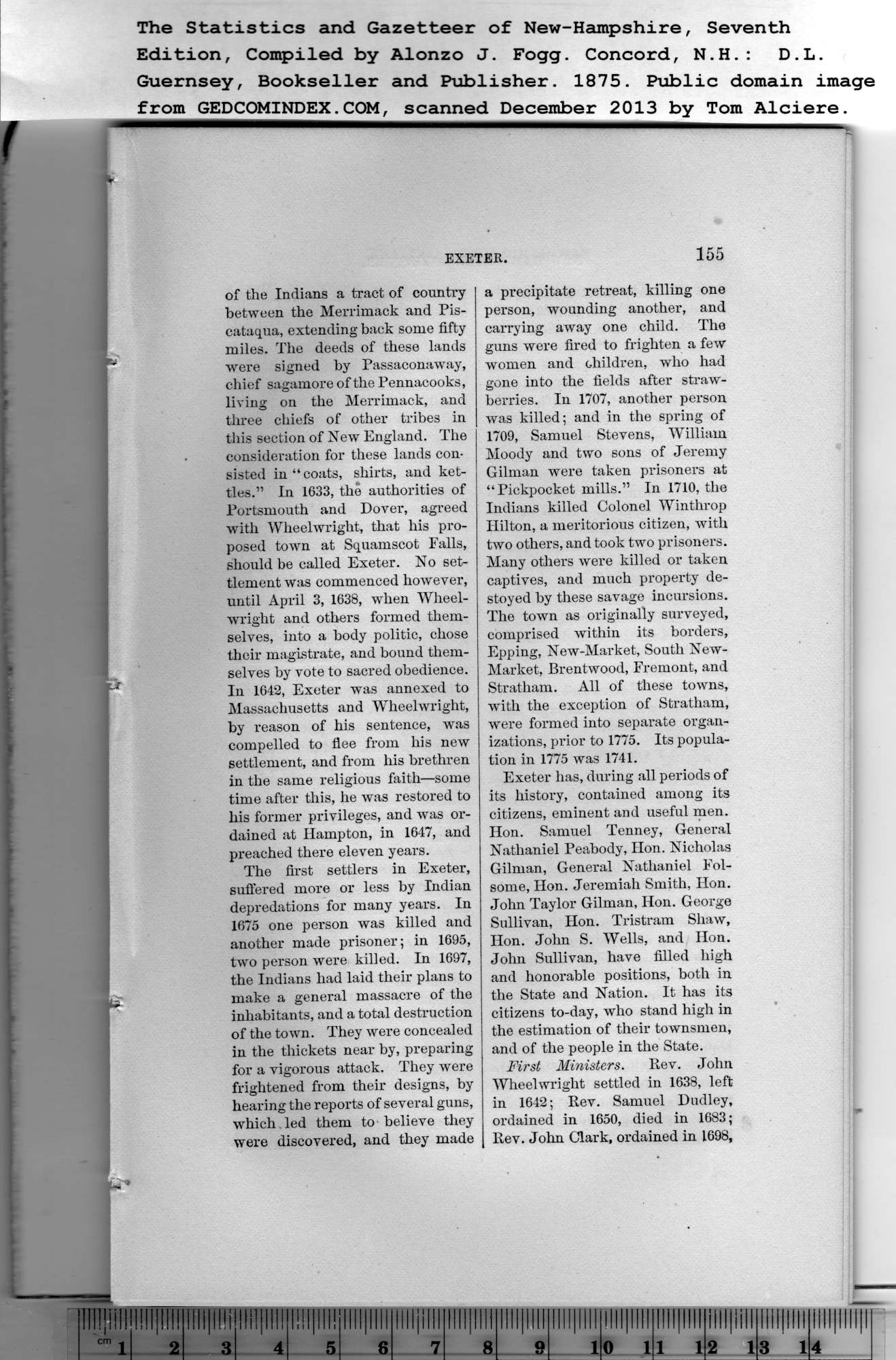|
of the Indians a tract of country
between the Merrimack and Pis-
cataqua, extending back some fifty
miles. The deeds of these lands
were signed by Passaconaway,
chief sagamore of the Pennacooks,
living on the Merrimack, and
three chiefs of other tribes in
this section of New England. The
consideration for these lands con-
sisted in “coats, shirts, and ket-
tles.” In 1633, the authorities of
Portsmouth and Dover, agreed
with Wheelwright, that his pro-
posed town at Squamscot Falls,
should be called Exeter. No set-
tlement was commenced however,
until April 3, 1638, when Wheel-
wright and others formed them-
selves, into a body politic, chose
their magistrate, and bound them-
selves by vote to sacred obedience.
In 1642, Exeter was annexed to
Massachusetts and Wheelwright,
by reason of his sentence, was
compelled to flee from his new
settlement, and from his brethren
in the same religious faith—some
time after this, he was restored to
his former privileges, and was or-
dained at Hampton, in 1647, and
preached there eleven years.
The Statistics and Gazetteer of New-Hampshire, Seventh
Edition, Compiled by Alonzo J. Fogg. Concord, N.H.: D.L.
The first settlers in Exeter,
suffered more or less by Indian
depredations for many years. In
1675 one person was killed and
another made prisoner; in 1695,
two person were killed. In 1697,
the Indians had laid their plans to
make a general massacre of the
inhabitants, and a total destruction
of the town. They were concealed
in the thickets near by, preparing
for a vigorous attack. They were
frightened from their designs, by
hearing the reports of several guns,
which. led them to believe they
were discovered, and they made |
155
a precipitate retreat, killing one
person, wounding another, and
carrying away one child. The
guns were fired to frighten a few
women and children, who had
gone into the fields after straw-
berries. In 1707, another person
was killed; and in the spring of
1709, Samuel Stevens, William
Moody and two sons of Jeremy
Gilman were taken prisoners at
“Pickpocket mills.” In 1710, the
Indians killed Colonel Winthrop
Hilton, a meritorious citizen, with
two others, and took two prisoners.
Many others were killed or taken
captives, and much property de-
stoyed by these savage incursions.
The town as originally surveyed,
comprised within its borders,
Epping, New-Market, South New-
Market, Brentwood, Fremont, and
Stratham. All of these towns,
with the exception of Stratham,
were formed into separate organ-
izations, prior to 1775. Its popula-
tion in 1775 was 1741.
Exeter has, during all periods of
its history, contained among its
citizens, eminent and useful men.
Hon. Samuel Tenney, General
Nathaniel Peabody, Hon. Nicholas
Gilman, General Nathaniel Fol-
some, Hon. Jeremiah Smith, Hon.
John Taylor Gilman, Hon. George
Sullivan, Hon. Tristram Shaw,
Hon. John S. Wells, and Hon.
John Sullivan, have filled high
and honorable positions, both in
the State and Nation. It has its
citizens to-day, who stand high in
the estimation of their townsmen,
and of the people in the State.
First Ministers. Rev. John
Wheelwright settled in 1638, left
in 1642; Rev. Samuel Dudley,
ordained in 1650, died in 1683;
Rev. John Clark, ordained in 1698, |
